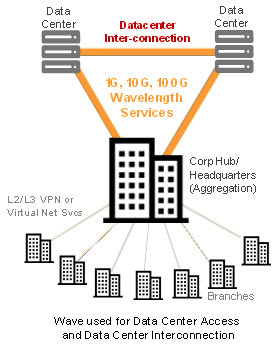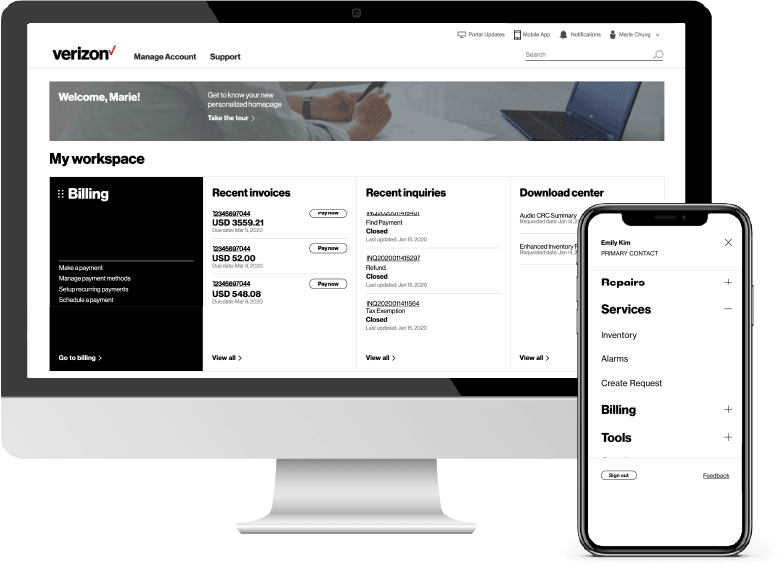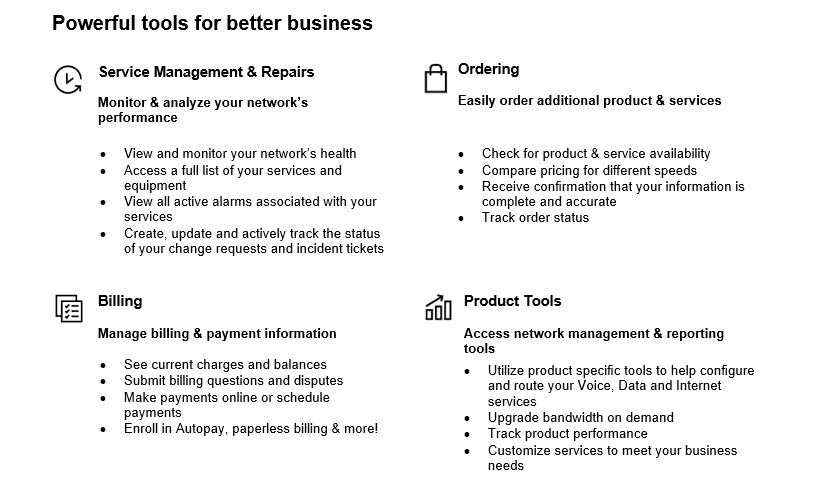-
Overview
-
The Wavelength Services Solution provides point to point Dense Wavelength Division Multiplexed (DWDM) transport of 1 Gigabit (G), 10G or 100G services via Ethernet, Optical Transport Network (OTN), Synchronous Optical Network/ Synchronous Digital Hierarchy (SONET/SDH) or Storage Area Networking (SAN) protocol handoffs. Verizon’s state of the art Ultra Long Haul network is used without packet switching or packet aggregation to minimize latency and lower costs for point to point circuits. Circuits are layer 1 physical circuits that are Optical Transport Network (OTN) multiplexed, standards-based multiplexing and may be OTN switched (akin to a semi-permanent cross-connect). The customer’s circuit is never manipulated at the packet level other than to map them into OTN frames for transport.
Wave Product Portfolio:
- Wavelength Services Solution - The standard Wave product is available in the Domestic US and in limited geography in EMEA and APAC. No-sign SOF (Service Order Forms) means contracting is simple and fast, with online terms and conditions. Point to point circuit options include 1GbE, 10 GbE, 100GbE, OC-192, STM-64, OTU2. The SLA (Service Level Agreement) features 99.5% network availability for un-protected service and up to 99.99% for protected service. It also carries a 4 hour Mean Time to Repair (MTTR) metric. All Wave products use our state of the art ROADM-based (Reconfigurable Optical Add Drop Multiplexer) DWDM (Dense Wavelength Division Multiplexer) networks. Access protection is an option. Our OTN mesh offers unique mesh restoration options at 10G that reduces the cost of protection. A Mandatory Route Option and Route Diverse Mated Pairs are also possible for long haul service. A RTD (Round Trip Delay) SLA is also an option for long haul service. This forward-looking platform will roll out 400GbE service in the coming years. Available in on-net or off-net locations or when the customer is co-located at one of our data centers or Points of Presence (POP).
- Linear Global Data Link (LGDL) - The legacy international wave product at 10Gb/s (via 10GbE, OTU2 or STM-64) or 100GbE or OTU4 offers the strong SLA metrics feature the same network availability as the standard product with tiered MTTR. LGDL is the lone product sold when circuits cross country borders.
- Metro Private Line (MPL) - The legacy domestic US metro Wave product supports point to point speeds at 2.5G (SONET), 10GbE, OTU2, 40GbE, 100GbE or OTU4, Fiber Channel at 1/2/4/10G. It also supports hub and spoke networking into 10G hub facilities that can fan out OC-3/12/48 or 1GbE or the Fiber Channel interfaces. Offnet is supported on one end. Customer co-locations are also supported. Circuits with Automatic Protection Switching are an option.
- Metro Private Line – Dedicated Multiplexing System (MPL-DMS) – A Private Wave ring product, it allows the customer to order private ROADM nodes at specified locations in a ring topology. These ROADMs are installed, provisioned and maintained by Verizon but the ROADM and its fibers are dedicated to one customer. MPL circuits are then ordered between them (called Appearances) as needed and support protected or un-protected appearances.
- US Private Line (USPL) – The legacy domestic US long haul wave service with point to point service at 10G (via 10GbE, OTU2 or OC-192), 40GbE, 100GbE, OTU4. USPL offers the same metrics for availability and MTTR as the standard product with like pricing. Route Diversity and Mandatory Route options are available, as is custom routing.
- Optical Wave Service (OWS) – The Verizon Incumbent Local Exchange Carrier (ILEC) intra-LATA Wave service within our ILEC region. Supports point to point speeds of 2.5G, 10G (10GbE or SONET OC-192) or 100GbE. Module Diversity and Route Diversity are available where the network supports them. Protection is also available. The SLA metrics match that of the standard product.
- Integrated Optical Wave Service (IOS) – The Verizon ILEC private ring product, IOS allows customers to order dedicated ROADMs at their specified locations in a ring topology and order appearances (circuits) between them. Un-Protected and Protected appearances are available and access from other products is also available. The fibers are also dedicated to the customer. The ROADMs and fiber are installed, provisioned and maintained by Verizon.
Here is a graphic depicting a typical Wavelength Services use case:

Verizon can provide Wave service to off-network (off-net) locations, shared data centers, on-net buildings or customer co-locations in our Point Of Presences (POPs), where customer provided access is supported through Circuit Facility Assignments (CFA) provided for the customer. Cross-connects in shared data centers are ordered by the customer using our CFA form for port details.
- Wavelength Services Overview
- Your Verizon Team
- Preparing your site
- Preparing for a successful delivery
- Installation
- Business continuity plan
- Manage your account with Verizon Enterprise Center
- Service features
- Network Operations Center (NOC)
- Training and service contact information
- Frequently asked questions
- Important Links
-
Your Verizon team
-
Your Verizon Services team (also known as your Wavelength Delivery Team) will help guide you through the full scope of Verizon services from contract signature to the engagement of your Order Manager and the Verizon Service Assurance team.
Order Manager
Your Order Manager tracks the progression of the order and communicates updates as needed in the form of periodic emails and/or follow up calls to provide status on key milestones regarding the implementation and activation of your Wavelength Services. The Order Manager will work all aspects of the order directly with you and will gather any additional information needed.
Solutions Architect
Your Solutions Architect (SA) is responsible for the physical and logical design and development of your network.
Below is a list of activities to be performed by the Solution Architect:
- Review & verify your hardware and software configurations.
Review redundancy, availability requirements, and security requirements.
-
Preparing your site for a successful Wavelength Services implementation
In working with Verizon, you will interface with various groups to ensure your Wavelength service implementation is a success. The graphic below shows you the roles and responsibilities of groups involved:

Over the next few weeks, a Verizon Order Manager (OM) will be assigned to facilitate the implementation of the circuit(s) you ordered. Verizon will be contacting you to review the order details and begin the implementation process. Our goal is to keep you informed and aware of all the steps.
Note: The following situations may result in a delayed activation of your Wavelength services: lack of customer response, local connectivity concerns, and loop installation refusals. Please ensure your remote locations are prepared to allow access to technicians for new installs in order to prevent these types of issues from occurring.
-
To successfully deliver your Wavelength Services, there are some activities that must be completed by both Verizon and you. Our goal is to keep you informed and aware of all the steps.
Verizon and Customer Steps
Over the next few weeks, a Verizon Order Manager (OM) will be assigned to facilitate the implementation of the circuit(s) you ordered. The OM will be contacting you to review the order details and begin the implementation process. A few key steps occur during this process. Our goal is to keep you informed and aware of all the steps.
A successful implementation of your new service requires your active involvement. We’ve provided the steps below to help you understand what to expect and how to prepare your facility for a smooth installation:
Agree on the scheduled implementation timeline with your Order Manager.
Note: The following situations may result in a delayed activation of your Wavelength services: lack of customer response, local connectivity concerns, and loop installation refusals. Please ensure your remote locations are prepared to allow access to technicians for new installs in order to prevent these types of issues from occurring.
- Verify site-specific information and configuration prior to submitting an order to Verizon so that orders meet with site requirements for Wavelength Services activation.
Customer action
The address information in your most current database should be supplied, and verification should include confirmation of the address recorded in the 911 database.
- Notify your local site contact(s) (LCON) of pending orders and ensure they are aware Verizon and the local exchange company (LEC) or 3rd party vendor may contact them to verify site information.
Customer action
Confirm your LCON contact details (phone numbers, email, etc.) before submitting orders to Verizon.
- Once notified by Verizon of the Telco tentative dispatch date, call each of your LCONs to ensure he or she will be on site and knows about the pending order. If the LCON will be out of the office, an alternate contact must be designated.
- Instruct the LCON to direct the LEC/3rd party vendor to the location where the circuit demarcation is to be placed and advise them if the demarcation point (demarc) must be extended to that point.
- Ensure adequate conduit is available to extend the demarc from the Minimum Point of Entry (MPOE) to the ultimate extended demarc location.
- Notify Verizon as far in advance as possible of any times during which activations may not be scheduled as the project schedule may be impacted
- Approve a priority list of sites to be scheduled for activation. However, do not schedule any circuit for activation until Verizon indicates the circuit is ready.
Note: If a change to the established activation schedule is required, communicate those changes at least 72 hours in advance of the scheduled activation date and receive acknowledgment from Verizon.
- Confirm the industry standard physical interface specification that matches the Verizon interface. The Verizon standard-based physical interface (PHY) and the protocol (Ethernet, SONET, OTN, Fiber Channel) must match the PHY and protocol on the customer’s equipment ports.
- See the Wavelength Services Interface Specifications for options at your contracted bit rate and protocol [Ethernet, Optical Transport Network (OTN), Synchronous Optical Network (SONET), and Synchronous Digital Hierarchy (SDH)].
-

-
As a part of your Wavelength Services with Verizon, installations may be required for the services you need. If you choose to use Verizon for your installation needs, note the following steps will occur:
1. Any required data will be gathered and validated by the Order Management team:
- Confirmation of the Verizon services ordered
- Coordinate activation date around customer readiness timelines
- Information on a knowledgeable local contact including name, address, phone number, and email.
- This person will need to provide access to the premises, telecommunications closets, and other network facilities at the location.
-
All orders are subject to verification and acceptance
✓ To help prevent delays to the order
✓ Capture Critical Site Information
✓ Create Local Contact awareness
✓ Promote On-Time Delivery
✓ Customer Satisfaction
✓Accuracy of service delivered
Once we have gained the proper confirmations, your order will be submitted requesting best date possible (contingent on network and equipment availability using standard interval or customer preferred date. There’s also a customer paid expedite option (if needed), dependent on your needs.
2. Your local contact must notify Verizon when the site is ready, or if there are any delays in room preparation.
- If the site is deemed not ready by Verizon, activation may be delayed.
Note: Issues like a lack of customer response, local connectivity concerns, and loop installation refusals may result in a delayed activation of your Wavelength Services.
3. Following the physical installation, please notify your Order Manager to complete service activation.
4. 3rd Party/Self-installations
If you choose to have your installations performed by a 3rd party or through your internal means, it is your responsibility to provide any updates or details to the Order Manager.
Note: Only installation services purchased through Verizon would be coordinated by your Order Manager.
At this time, you should have a 3rd party network vendor chosen, or have determined you have the internal resources available to complete this activity. If you should look to have Verizon provide the necessary services for successful implementation of your Private IP circuits, speak with your account representative for more details.
- If the site is deemed not ready by Verizon, activation may be delayed.
-
Service disruptions can hurt a company's bottom line and compromise an organization's mission. The economic and reputational imperatives of the current market have shifted the discussion from IT disaster recovery to an enterprise-wide business continuity focus.
Organizations of all sizes and industry types should have ongoing, enterprise-wide Business Continuity (BC).Programs that develop, prepare and exercise the various areas of continuity from critical business processes to IT service availabilities. The Business Continuity Program should address areas such as Emergency Response, Impact Analysis, Business Continuity Plans, Disaster Recovery Plans, Supplier Plans, Exercises, and ongoing BC program management.
The goals of today’s most relevant Business Continuity Programs are those providing organizations with an enterprise-wide business continuity focus, that not only includes strategizing and planning for IT service availability and disaster recovery, but addresses the ability to manage all areas of critical and continuity activities of the program to help prepare and mitigate the impact from ever-increasing risks threatening to interrupt organizations’ critical processes.
Key criteria your organization should consider when creating a relevant, enterprise-wide Business Continuity Program to help protect your business critical information and processes- The Executive Team has established enterprise-wide business continuity objectives
- The Business Continuity Program is
- Enterprise-wide, and extends beyond the IT department
- Part of the organization’s annual operational budget
- An on-going, steady-state operation of the business
- Regular assessments and reviews to validate business recovery requirements, priorities capabilities and compliance requirements
- IT Service strategies and recovery solutions to maintain effective service resiliency and availability align to the business requirements
- Appropriate emergency response, business continuity, communications and disaster recovery plans are designed and developed to provide proper guidance during an event
- Regular BC Program maintenance is being performed to manage the program changes
- Determine if you can/will manage the BC Program internally, or using a BC partner
- If a BC partner, determine those with the best capabilities to manage your organization’s size and needs
- Confirm the group or persons managing your BC Program is qualified, they have references, ISO accreditations and BC certifications
- Annual exercises and tests are performed before an event happens, validating your plans effectiveness
- Develop clear and simple methods, policies and procedures to follow
- Keep all resources properly trained
- Once the event is over, you should have a plan in place to bring your business back to normal operations
Verizon can help you with your Business Continuity planning needs
Verizon's portfolio of Business Continuity Consulting, Planning and Management help reduce the risk and impact from a disruption by providing enterprise-wide Business Continuity Programs that generate strategic solutions, formulate plans and manage program preparations to provide effective continuity measures should an unavoidable crisis occur.
With the Verizon Business Continuity Management portfolio of consulting services and programs, we help our customers to effectively prepare and maintain continuity during planned and unplanned events to help reduce the risk and impact from disruptions. Please contact your Verizon account team for further assistance.
-
Easily Manage your Services Online
The Verizon Enterprise Center makes it easy for you to monitor, manage, analyze and optimize your Verizon products and services online. Available seamlessly between desktop, tablet and smartphone – you can act on your crucial data wherever your work takes you.
-

-
Register for the Verizon Enterprise Center
- Go to sso.verizonenterprise.com/ or download the My Verizon for Enterprise mobile app
- Click the ‘Register’ link
- Enter the invitation code you received to complete registration.
-

-
Bit Rates and Protocols
The 1 GbE speed is available in the standard product as a standalone interface and in the legacy Metro Private Line Wave (MPL) product as an appearance in a channelized 10G.
The 100G speed is available in legacy MPL and USPL (US Private Line) products until late 2019 when it is introduced in the standard product.
OTN (Optical Transport Network) interfaces are standardized by the International Telecommunications Union via ITU-T recommendations. Our standards-based OTN handoffs include OTU2 and OTU4 (via ITU-T G.959.1 Application code 4I1-9D1F (equivalent to 100GBASE-LR4 for Ethernet). LC connectors are standard for all services. See the Wave Interface Specifications document for more detail on all customer interfaces.Storage Area Network (SAN) handoffs include Fiber Channel 1/2/4 and FC 8 (Where available) and FC10 (where available). SAN handoffs are limited to metro service on the legacy Metro Private Line Wave product.
-
- Synchronous Optical Network (SONET) interfaces include OC-3, OC-12, OC-48 on Metro channelized 10G or on Private Rings and OC-192 (labeled as Transparent Synchronous Frame or TSF) which features transparent transport of the K bytes and D bytes in the line overhead. TSF is also available in the Synchronous Digital Hierarchy (SDH) frame format internationally for STM-64. See the interface specs for more detail on SONET behaviors.
- Wave optional features include:
- Protection in the access, metro and/or the long haul transport.
- Mandatory Route or Diverse Routed Mated Pairs of circuits and street level KMZ maps of your circuits.
- Round Trip Delay (RTD) SLAs for guaranteed maximum latency.
- Private Rings are available for the enhanced security and diversity.
- Customer Controlled Provisioning (CCP) solutions for service agility of 1G or 10G circuits within a 10G or 100G backbone.
- Enhanced network availability options via CCP to eliminate single points of failure and backed by an increased SLA metric for network availability (uptime).
- Layer 1 encryption for 10G or 100G via CCP that eliminates the bandwidth penalties of Internet Protocol Security (IPSEC) or Media Access Control Security (MACSEC).
-

-
Upon successfully completing the requirements of your Wavelength Services, your network services will be handed off to the Verizon Network Operations Center, which oversees incident management.
The Network Operations Center performs automatic alarm detection, fault isolation, event and maintenance correlation. The Network Operations Center also provides deep visibility into the circuits and equipment that make up your network to help more effectively manage your services. The NOC Transport monitors your networks through a Network Management System application that actively monitors the Dense Wavelength Division Multiplexed (DWDM) transport equipment for alarms and conditions.
-
For all Wavelength Services levels, Verizon will proactively monitor your network, isolate faults, and notify you in the event of an alarm. Rapid Fault Isolation enables Verizon to test network elements in parallel, automatically. Verizon can proactively detect a customer outage, perform fault isolation, and initiate repair action, in many cases without human intervention
-
Our transport equipment uses fault propagation via the IEEE 802.3 standard LF and RF ordered sets with transport implementation via ITU-T standard G.709.
For further details on tickets and priorities under Fault Management, ask your Verizon Account Team for details.
-
Verizon’s objective is to restore your services to their normal operating conditions quickly and efficiently. To accomplish this objective, The NOC and the Service Desk use escalation guidelines set up to drive issues to resolution.
Instead of escalating on the basis of time, escalations are value-based. The objective is to add value to the escalation process across the board for all customers and all circumstances, as well as to add standardization to the processes.
-
Verizon strives to perform network maintenance activities with little or no disruption to our customers. However, regular and sometimes emergency maintenances are unavoidable. Every attempt is made to schedule your maintenance windows during weekends, late night, or early morning hours to reduce negative impact.
See also the Service Assurance Guides in the www.enterprise.verizon.com website for more info.
Customer action
Contact your Verizon Account Team about setting up Verizon network maintenance activities notifications.
-

-
Training
The Customer Learning Portal provides Verizon Business customers with training and resources for products, systems, and tools. To access the Customer Learning Portal, please go to https://sso.verizonenterprise.com/.
Service Contact Information
The matrix below will provide you with the contact information you would need to handle any issues that may arise with your Wavelength services:
Service issue
Repair
Be prepared with the following information
Service Instance identifier
Verizon enterprise center portal
Verizon Enterprise Center Link
Service team
Contact Assigned Service Team or subscribe to Premium Client Services (PCS)
Call
https://enterprise.verizon.com/support/ > select support > select country
Verizon enterprise center live chat
Verizon Enterprise Center Link – Chat
(available under “Support” > “Contact Us & Send Feedback”)
Account team
Contact Assigned Account Team>
Service issue
Maintenance Notification
Be prepared with the following information
Refer to the notification email
Verizon enterprise center portal
N/A
Service team
Contact Assigned Service Team or subscribe to Premium Client Services (PCS)
Call
Contact Verizon with the contact information provided on the maintenance notification email
Verizon enterprise center live chat
N/A
Account team
Contact assigned account team
Service issue
Verizon Enterprise Center Tools and Training
Be prepared with the following information
N/A
Verizon enterprise center portal
Verizon Enterprise Center Link
Service team
Contact Assigned Service Team or subscribe to Premium Client Services (PCS)
Call
Send an e-mail to: [email protected]
Verizon Enterprise Center Live Chat
N/A
Account team
Contact assigned account team
Service issue
Billing
Be prepared with the following information:
Billing Account Number / Service ID/ Location ID
Verizon enterprise center portal
Verizon Enterprise Center Link
Service team
Contact Assigned Service Team or subscribe to Premium Client Services (PCS)
Call
https://enterprise.verizon.com/support/ > select support > select country
Verizon enterprise center live chat
Verizon Enterprise Center Link – Chat (available under “Support” > “Contact Us & Send Feedback”)
Account team
Contact assigned account team
Service issue
Order
Be prepared with the following information:
Service Instance identifier
Verizon enterprise center portal
Verizon Enterprise Center Link *
Service team
Contact Assigned Service Team or subscribe to Premium Client Services (PCS)
Call
Contact Assigned Account Team
Verizon enterprise center live chat
Verizon Enterprise Center Link – Chat (available under “Support” > “Contact Us & Send Feedback”)
Account team
Contact Assigned Account Team
The Service Level Agreement (SLA) applies to Verizon’s Wavelength Services on an end-to-end basis, including Local Access provided by Verizon in conjunction with Wavelength Services.
Service Level Class defines the overall level of protection for a Wavelength Services end-to-end circuit. The Service Level Class is derived from the combination of loop/access and core segment protection types for a specific circuit. Specific Service Level Standards are associated with each Service Level Class:
- Unprotected. Verizon will provide a Wavelength Services circuit that is unprotected end-to-end. Loop/Access segment(s) is unprotected and Wavelength Service segment is unprotected.
- Protected Access. Verizon will provide a Wavelength Services circuit that is only protected in the Local Access segment. Loop/Local Access segment(s) is either protected or unprotected and Core segment is unprotected. This Service Level Class requires that at least one Local Access segment is protected.
- Protected Dual Path. Verizon will provide a Wavelength Services circuit that is protected end to end. Loop/Local Access segment(s) is protected and Core segment is protected. Protected Dual Path can be a metro service or a long haul service with protected IXC transport and protected access on both ends.
- Protected IXC. Verizon provides a Wavelength Service circuit that is protected in the IXC transport but is provisioned with un-protected access on either end (either on-net or off-net access).
The Circuit Availability Standard applies only to “Hard Outages”, i.e., an inability to exchange data end to end. Service is not considered unavailable until at least 60 consecutive seconds of unavailability have elapsed during any 15 minute interval.
Service Level Class Name |
Circuit Availability |
Unprotected |
99.5% |
Protected Access (both ends) |
99.75% |
Protected Dual Path (metro protection or IXC protection with protected access on both ends) |
99.99% |
Protected IXC (Protected IXC transport and one or more ends with un-protected access) |
99.75% |
If there are any new installations with your new Wavelength Services, the expected timeline for service delivery is related to several onsite activities (construction, LEC coordination, demarcation extension, equipment placement, permits/approvals, etc.).
Your Order Manager will work with you to coordinate any on-site activities associated with your installation and to answer any questions that may arise.
The contract includes online Terms and Conditions that are service-specific. These are located in the Service Publications and Price Guide.
Your business continuity relies on your data center interconnects and access circuits from your aggregation nodes to those data centers because that traffic is now typically transactional and not just data replication. Your business continuity therefore depends on these connections and is paramount. Increasing resiliency (the ability to withstand failures in the network) is a key objective to ensure your business continuity.
A means of improving resiliency is to increase the network availability (the percentage of uptime relative to the measurement period) of your network connectivity.
You can improve the network availability with the use of certain network architectures for your network of Wavelength Services circuits (which is often a triangle of data centers and aggregation nodes, such as Headquarters). There are several architectures that can increase that availability and therefore the ability of your business to withstand single and multiple network failures.
Deploying two separate Wave circuits to different router ports and ensuring they are diversely routed is a minimum architecture. That prevents many single points of failure (such as Router port failures, most of the carrier’s equipment failures and most fiber outages) for a data center interconnects, but not all of them.
Even with a pair of diversely routed circuits, there are still “single points of failure” in the network. Eliminating these increases the overall network availability. Network managers often deploy dual routers at each node eliminate the Router chassis as a single point of failure.
A next step to increase resiliency would be to deploy layer 1 automatic protection switching on each of the two Wave circuits, which increases each circuit’s network availability significantly. The much improved uptime for each circuit results in a far superior network availability of the pair.
Protection is available for the access and the long haul transport (if any) as an option for your service. Diversity between two circuits is also available when requested and the network supports it.
The network availability metric in each circuit’s Service Level Agreement (SLA) increases from 99.5% for un-protected service to 99.99% when protected end to end. Un-protected Service has SLA of 99.5% (1.8 days of statistical outage per year) whereas end to end protected service SLA is 99.99% (only 52 min of outage per year). See your account manager to discuss options.
With Verizon Enterprise Center Mobile, you have access to information you need to manage your critical business functions on-the-go. You can manage your Verizon account from a smartphone or a tablet using the mobile application for single sign-on access to Verizon Enterprise Center, My Business Account.
Smartphone users can download an app from Google Play or the App Store that supports access to Verizon Enterprise Center, My Business, and Verizon portals. Simply search for “My Verizon Enterprise;” download the app; and conveniently launch right into Quick Tasks or sign in to your business portal for more management options. An icon is added to your phone’s home screen for easy access the next time you log in. Requirements are as follows:
- App Store: Apple iPhone models that have at least a 13.x iOS version in the U.S. on any carrier or Wi-Fi network.
- Google Play: Selected devices using an operating system of Android 5 or higher in the U.S. on any carrier or Wi-Fi network
You can also access Verizon Enterprise Center Mobile with a tablet by signing into a browser-based application at http://verizonenterprise.com. The tablet functionality will be the same as the smartphone app, supporting key business functions that vary by the users’ portal and permissions. Accessing the Verizon Enterprise Center from a mobile device or tablet will not provide the same options as the desktop version.
Verizon Enterprise Center portal users can use Quick Tasks for repairs, billing, and some wireless functions or sign-in to get access to key business functions delivering near real-time information to you.
There may be a time in which you need to make a change to your service. You can submit a ticket through Verizon Enterprise Center.
If you have a need to place an additional Wavelength Services order, contact your Verizon Account Team.
During your network services implementation, you will identify contacts within your organization to be notified in the event of outages. Notifications are e-mailed to these contacts after a trouble ticket has been opened. These e-mails include a ticket number (e.g., 2013103101249 in a year/month/day/ticket number format) that may be entered into Verizon Enterprise Center to review.
If notification is not received from Verizon, you may contact Verizon to open a ticket through the Verizon Enterprise Center portal or through Verizon Customer Service at http://www.verizonenterprise.com/ > select contact us > select country > select support.
Yes, Verizon has professional services to assist with your Wavelength Services implementation, as well as other service needs.
Ask your Verizon Account Team for more details.
Billing for Wavelength Services will commence when the service is implemented by the Design or Implementation Engineer and is handed over to the NOC for management.
Your billing terms are outlined in your contract terms and Verizon Services Agreement.
A billing tutorial can be found via this link (log-in required).
User Guides for billing and invoices are available on the Customer Training and Documentation website via the following link.
Wavelength Services are available in North America, Europe, Middle East and the Asia Pacific regions. Our extensive submarine network and terrestrial networks support truly global connectivity.
For detailed information on Wavelength Services, please contact your Verizon Account Team and also refer to the standard product’s list. Individual Case Basis (ICB) and legacy products are documented separately.
A feature that identifies a route restriction between city pairs. It is a logical level commitment to maintain Long Distance Point Of Presence (POP) level routing for the life of the circuit.
- Selected during quoting
- Included in the contract
- Part of the circuit record for service assurance.
An optional feature that provisions two separate circuits and routes them to be geographically diverse, reducing the chances that the fiber will be a single point of failure affecting both circuits. While the network availability (uptime) is not increased for each of the two circuits, it does increase the uptime for the pair as a whole. This is a first step that network architects take to improve resiliency and enhance business continuity. Often, they’ll also deploy dual routers and may even deploy protection on each of the circuits.
Note that two circuits, each with the Mandatory Route option will also affect a route diverse pair.
A protected circuit copies the customer’s traffic into a working and protect channel, that are typically routed diversely and at the receive end, one stream is selected. If a failure of equipment or fiber occurs, the Verizon system will automatically switch to receive traffic from the other channel. This greatly increases the uptime (network availability) of a circuit.
Services and/or features are not available in all countries/locations, and may be procured from in-country providers in select countries. We continue to expand our service availability around the world. Please consult your Verizon representative for service availability. Contact us.

